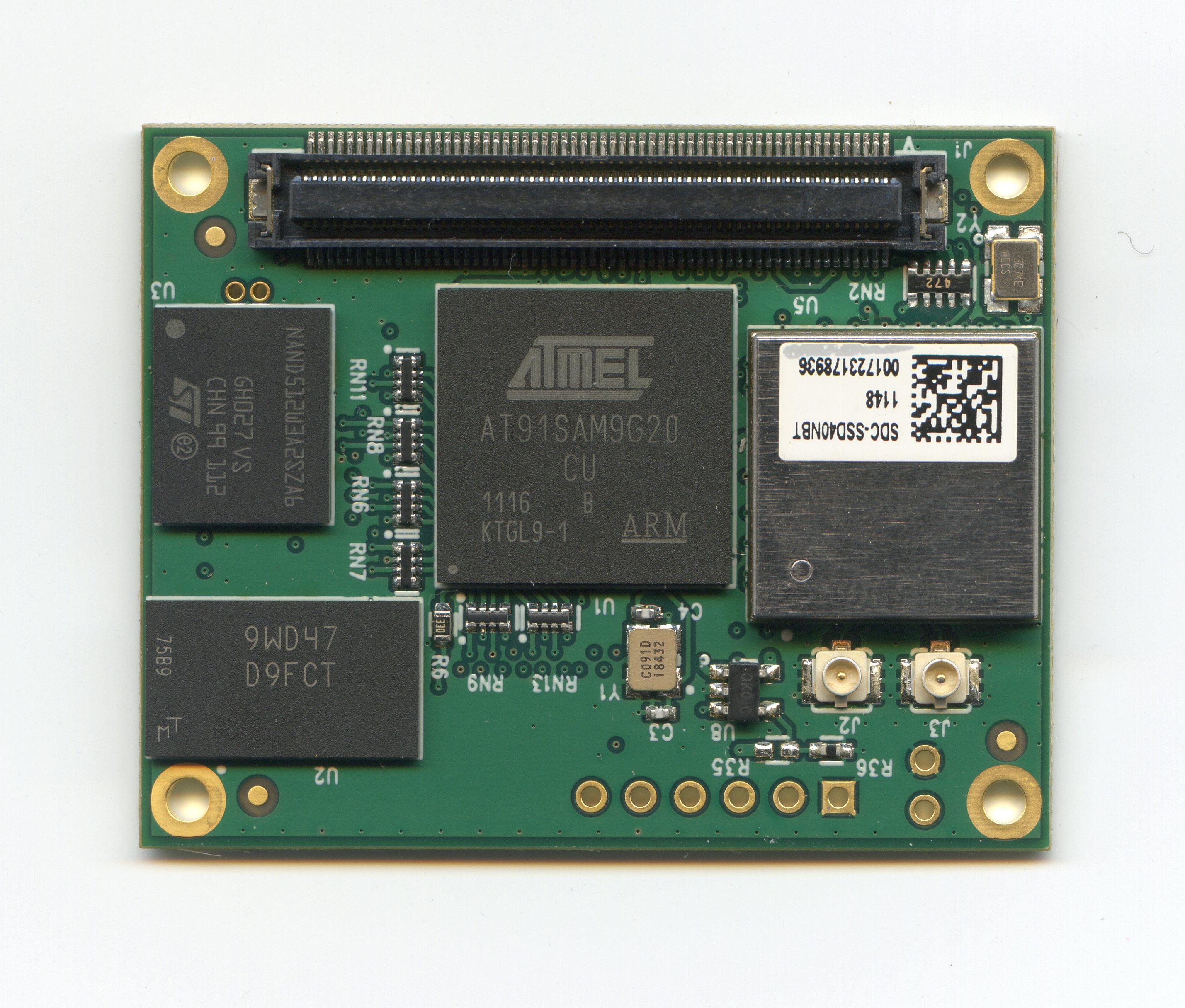WB40NBT

Overview
The SDC-WB40NBT is a Wi-Fi and Bluetooth Device Server module that supports 802.11a/b/g/n and Bluetooth 2.1. The module is a complete wireless communications subsystem that may be integrated into a variety of host devices via a number of available electronic and logical interfaces including UART, SPI, SDIO and Ethernet. The module features a fully integrated IP stack and web server running on a Linux 3.0 kernel and may be accessed via a provided command line or browser interface for easy configuration and monitoring.
Buy Now
Specifications
| Part Number | Price @ 1k | Antenna Type | Chipset (Wireless) | Frequency Range (Max) | Frequency Range (Min) | Frequency Range 2 (Max) | Frequency Range 2 (Min) | Logical Interfaces | OS/Software | Product Type | System Architecture | Technology | Type |
|---|---|---|---|---|---|---|---|---|---|---|---|---|---|
SDC-WB40NBT EOL Buy Options | N/A | External | Broadcom BCM4329 | 2495 MHz | 2400 MHz | 5825 MHz | 5150 MHz | SPI, USB, I2C, GPIO, PCM, Ethernet, Serial, SDIO | Linux | Embedded Module | Hostless | 802.11abgn, Bluetooth Classic | Module |
Documentation
Datasheet 1 total
Name |
Part |
Last Updated |
|---|---|---|
| Datasheet - WB40NBT.pdf | All | 09/05/2024 |
Application Note 2 total
Name |
Part |
Last Updated |
|---|---|---|
| Application Note - Guidelines for Replacing Antennas | All | 03/20/2025 |
| Application Note - WB Firmware Update.pdf | All | 01/17/2019 |
Software 3 total
Name |
Part |
Last Updated |
|---|---|---|
| src wb40n-laird-3.4.1.1.tar.bz2 | All | 01/17/2019 |
| wb40n-laird-3.4.1.1.tar.bz2 | All | 01/17/2019 |
| wb40nbt rev6 3d model.zip | All | 01/17/2019 |
Documentation 6 total
Name |
Part |
Last Updated |
|---|---|---|
| Application Note - 40 Series Bluetooth.pdf | All | 01/17/2019 |
| Quick Start Guide - WB40NBT.pdf | All | 01/17/2019 |
| Reference Guide - Common Vulnerabilities and Exposures | All | 02/14/2019 |
| User Guide - Laird Command Line Interface.pdf | All | 01/17/2019 |
| User Guide - Summit Software Developers Kit.pdf | All | 01/17/2019 |
| User Guide - WB40NBT Command Line Utility.pdf | All | 01/17/2019 |
Certification 9 total
Name |
Part |
Last Updated |
|---|---|---|
| Antenna DS - HS Sencity.pdf | All | 01/17/2019 |
| AS/NZS Certifications - WB40NBT | All | 10/02/2020 |
| EU Certifications - WB40NBT - 2020 | All | 10/06/2020 |
| FCC Certifications - WB40NBT | All | 10/02/2020 |
| ISED (Canada) Certifications - WB40NBT | All | 10/02/2020 |
| ISED ICES-003 Issue 7 Declaration of Compliance | All | 05/18/2021 |
| NCC (Taiwan) Certifications - WB40NBT | All | 10/02/2020 |
| Regulatory Information - WB40NBT | All | 06/10/2021 |
| RoHS 3 Compliance - Wi-Fi Products | All | 03/06/2025 |
Become an Ezurio Customer to Gain Exclusive Access to Our Design Experts
- Antenna Scans
- Antenna selection and placement
- Custom antenna design
- Worldwide EMC testing / certifications
- Embedded RF hardware / firmware design
- Cloud architecture and integration
- Mobile application development
- Product & Industrial Design
Distributors
| Distributor | Phone Number | Region | Website |
|---|---|---|---|
| Arrow Electronics | 1-855-326-4757 +44 2039 365486 |
APAC, North America, South America, EMEA | Website |
| Braemac Australia, New Zealand, South East Asia | +61 2 9550 6600 +64 9 477 2148 |
APAC | Website |
| DigiKey | 1-800-344-4539 |
North America, South America, APAC, EMEA | Website |
| EBV Elektronik | EMEA | Website | |
| Farlink Technology China, Hong Kong | +86 13266922199 |
APAC | Website |
| Farnell | 1-800-936-198 +44 3447 11 11 22 |
EMEA | Website |
| Future Electronics | 1-800-675-1619 1-514-428-8470 |
North America, South America, APAC, EMEA | Website |
| Glyn | +49-6126-590-0 |
EMEA | Website |
| Hy-Line Germany Only | +49 89 614 503 0 |
EMEA | Website |
| Jetronic China, Hong Kong and Taiwan | 852-27636806 |
APAC | Website |
| M2M Germany | +49-6081-587386-0 |
EMEA | Website |
| Martinsson | +46 8 7440300 |
EMEA | Website |
| McCoy South East Asia | +65 6515 2988 |
APAC | Website |
| Mouser Electronics | 1-800-346-6873 +44 1494 427500 |
North America, South America, APAC, EMEA | Website |
| RS Components | +852-2421-9898 +44 3457-201201 |
North America, South America, APAC, EMEA | Website |
| Ryoyo Japan | +81-3-3543-7711 |
APAC | Website |
| Solsta UK Only | +44 (0) 1527 830800 |
EMEA | Website |
| Supreme Components International India, South East Asia | +65 6848-1178 |
APAC | Website |
| Symmetry Electronics | 1-866-506-8829 |
North America | Website |
| Tekdis Australia and New Zealand | +61 3 8669 1210 |
APAC | Website |
| Telsys | +972 3 7657666 |
EMEA | Website |
| WPG | +44 1628 958460 |
EMEA | Website |
 Laird Connectivity is now Ezurio
Laird Connectivity is now Ezurio

/filters:background_color(white)/s3fs-public/2018-10/Embedded%20Wireless-WB40NBT.jpg)